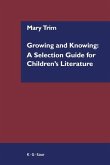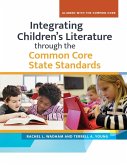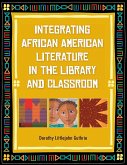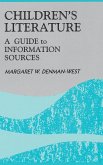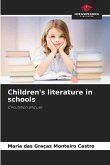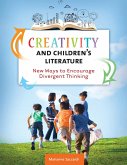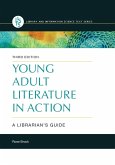Christie Kaaland
The Children's Literature Selection Handbook, K-8
Christie Kaaland
The Children's Literature Selection Handbook, K-8
- Gebundenes Buch
- Merkliste
- Auf die Merkliste
- Bewerten Bewerten
- Teilen
- Produkt teilen
- Produkterinnerung
- Produkterinnerung
Offering future school librarians, teachers, and working librarians an alternative to lengthier textbooks on children's literature, this engaging book introduces readers to the most important genres and current conversations in the field while leaving them time to read children's literature directly.
Andere Kunden interessierten sich auch für
![Growing and Knowing: A Selection Guide for Children's Literature Growing and Knowing: A Selection Guide for Children's Literature]() Mary TrimGrowing and Knowing: A Selection Guide for Children's Literature138,99 €
Mary TrimGrowing and Knowing: A Selection Guide for Children's Literature138,99 €![Integrating Children's LIterature through the Common Core State Standards Integrating Children's LIterature through the Common Core State Standards]() Rachel WadhamIntegrating Children's LIterature through the Common Core State Standards47,99 €
Rachel WadhamIntegrating Children's LIterature through the Common Core State Standards47,99 €![Integrating African American Literature in the Library and Classroom Integrating African American Literature in the Library and Classroom]() Dorothy GuthrieIntegrating African American Literature in the Library and Classroom43,99 €
Dorothy GuthrieIntegrating African American Literature in the Library and Classroom43,99 €![Children's Literature Children's Literature]() Margaret Denman-WestChildren's Literature63,99 €
Margaret Denman-WestChildren's Literature63,99 €![Children's literature in schools Children's literature in schools]() Maria das Graças Monteiro CastroChildren's literature in schools36,99 €
Maria das Graças Monteiro CastroChildren's literature in schools36,99 €![Creativity and Children's Literature Creativity and Children's Literature]() Marianne SaccardiCreativity and Children's Literature47,99 €
Marianne SaccardiCreativity and Children's Literature47,99 €![Young Adult Literature in Action Young Adult Literature in Action]() Rose BrockYoung Adult Literature in Action62,99 €
Rose BrockYoung Adult Literature in Action62,99 €-
-
-
Offering future school librarians, teachers, and working librarians an alternative to lengthier textbooks on children's literature, this engaging book introduces readers to the most important genres and current conversations in the field while leaving them time to read children's literature directly.
Produktdetails
- Produktdetails
- Verlag: Bloomsbury Libraries Unlimited
- Seitenzahl: 256
- Erscheinungstermin: 18. September 2025
- Englisch
- Abmessung: 260mm x 183mm x 18mm
- Gewicht: 683g
- ISBN-13: 9798216186168
- Artikelnr.: 74172687
- Herstellerkennzeichnung
- Libri GmbH
- Europaallee 1
- 36244 Bad Hersfeld
- gpsr@libri.de
- Verlag: Bloomsbury Libraries Unlimited
- Seitenzahl: 256
- Erscheinungstermin: 18. September 2025
- Englisch
- Abmessung: 260mm x 183mm x 18mm
- Gewicht: 683g
- ISBN-13: 9798216186168
- Artikelnr.: 74172687
- Herstellerkennzeichnung
- Libri GmbH
- Europaallee 1
- 36244 Bad Hersfeld
- gpsr@libri.de
Christie Kaaland, EdD, is a Core Faculty member of Antioch University Seattle, USA, where she designed, launched, and co-chairs Antioch University's graduate school library certification program. Kaaland is the former associate editor of Teacher Librarian: The Journal for School Library Professionals and has been guest editor of school library advocacy-themed issues of Knowledge Quest and Vanderbilt University's Peabody Journal. Her writing and research interests are school library advocacy and children's literature. In 2021, she won the Washington Library Association President's Award.
Contents
Introduction
Chapter 1 Genres of Fiction
Children's Classics
Historical Fiction
Realistic Fiction
Animal Realism
Contemporary Realism
Romance Novels
The Coming-of-Age or Problem Novel
Fantasy
High Fantasy
Speculative Fiction
Dystopian Novels
Science Fiction
Adventure and Survival Stories
Animal Fiction
Horror
Humor
Mysteries
Sports Stories
Genre-Blending, Genre-Bending
Children's Literature References
Chapter 2 Illustrated Picture Books
Story Books
Literary Themes in Storybook Picture Books
Humorous Storybook Picture Books
Concept Books
Alphabet Books
Counting Books
Predictable Books
Participation Books
Circle Stories
Cumulative Tales
Wordless Picture Books
Picture Books for Older Readers
Metafiction
Illustrations: The Art of the Picture Books
Visual Elements
Color
Visual Perspective
Line and Shape
Texture
Illustrators' Media
Drawing Media: Charcoal, Chalk, Pen and Ink, Pastel Oils, Colored Pencils,
Markers
Watercolor and Gouache
Acrylics
Oil Paintings
Woodcutting
Collage
Photography
Mixed Media
Digital Art
Border Art
A Final Note
Children's Literature References
Chapter 3 Nonfiction
Selection Considerations for Nonfiction
Organization
Text Structure: Design and Layout Features
Accuracy
Cultural Authenticity
The Author's Voice: Style, Tone, and Authority
Nonfiction Text Features
Awards for Nonfiction
Types of Nonfiction
Concept Books
Survey Nonfiction
Activity Books
Trivia of Fact Books
Narrative Nonfiction
Reference Books
The Steward and Correia Model: The Five Types of Nonfiction
A Final Note
Children's Literature References
Chapter 4 Biography
Autobiographies: An Author's Life
Collective Biographies
Biography and the Curriculum
Selecting Biography Books
Biographies of Whom?
Picture Book Biography's Golden Age
Biography Back Matter
Outstanding Picture Book Biographies
Children's Literature References
Chapter 5 Traditional Folk Tales
Everyone's Stories
Determining Authenticity of Folk Literature
The Value of Reading Traditional Tales
Types of Traditional Folk Literature
Ballads
Cumulative Tales
Fables
Fairy Tales
Legends
Myths and Mythology
Pourquoi Stories
Tall Tales
Trickster Tales
Nursery Rhymes and Mother Goose
Additional Folktales
A Final Note
Children's Literature References
Chapter 6 Poetry
Getting Kids to Love Poetry
Jason Reynolds
Kwame Alexander
Humorous Poetry
Formats of Poetry Books
Anthologies
A Single Illustrated Poem
Poems Presented Thematically
Poems Presented in Unique Formats
Bilingual Poetry
Song Lyrics
Novels in Verse
Curriculum Connections
Forms and Types of Poems
A Final Thought
Children's Literature References
Chapter 7 Graphic Novels
There's Value in Reading Graphic Novels
The Historic Context of Comics and Graphic Novels
Today's Popular Graphic Novels
Adaptations
Graphic Novel Series
Graphic Memoirs
Nonfiction
Fantasy and Sci-Fi
Graphic Novels for All Reader Types
English Language Learners
International Titles
Literary Themes and Motifs in Graphic Novels
Illustration Styles
Cartoon (or "Toon") Style
Western or Superhero Style
Manga's Anime Style
Manga
Graphic Novels Are Here to Stay
Children's Literature References
Chapter 8 Series
"Is There Another Book Like This?"
Additional Value of Series
Fiction Series
Nonfiction Series
Read On!
Children's Literature References
Chapter 9 Beyond Genres
Learning to Read: Literary Forms, Types, and Formats for Emerging Readers
Books for Beginning Readers
Early Readers
Reading Independence: Early Reader Series
Identifying, Labeling, and Finding Early Readers
Controlled Vocabulary Books, Transitional Fiction, Beginning Chapter Books
Controlled Vocabulary
Transitional Fiction, Beginning Chapter Books
Engineered Books
If You Want to Raise a Reader, Be a Reader
Children's Literature References
Chapter 10 International Children's Literature, Books in Translation, and
Bilingual Books
Types of International Children's Literature
Sharing Global Children's Literature with Students
International Literature Offers Global Perspectives
ELL and Students of an Immigrant-Refugee Experience
Bilingual Books
Selecting Non-English Books
A Final Word
Children's Literature References
Chapter 11 The Influence of Publishers and the Publishing Industry
How a Book Becomes a Book
The Agent
The Publisher and the Editor
The Production Team
The Publishing Industry
Diversity in Publishing
Children's Literature References
Chapter 12 Connecting with Authors and Illustrators
Inspiring Readership: Book Trailers, Blogs, Infographics, Websites, and
Author Visits
Author or Illustrator Visits
Virtual Visits
Field Trips
Author Websites
Blogs
Book Trailers
Reader Advisory
Book Clubs
A Final Reminder
A Final Word
Children's Literature References
Appendix: Children's and Young Adult Literature Awards
Professional References
Index
Introduction
Chapter 1 Genres of Fiction
Children's Classics
Historical Fiction
Realistic Fiction
Animal Realism
Contemporary Realism
Romance Novels
The Coming-of-Age or Problem Novel
Fantasy
High Fantasy
Speculative Fiction
Dystopian Novels
Science Fiction
Adventure and Survival Stories
Animal Fiction
Horror
Humor
Mysteries
Sports Stories
Genre-Blending, Genre-Bending
Children's Literature References
Chapter 2 Illustrated Picture Books
Story Books
Literary Themes in Storybook Picture Books
Humorous Storybook Picture Books
Concept Books
Alphabet Books
Counting Books
Predictable Books
Participation Books
Circle Stories
Cumulative Tales
Wordless Picture Books
Picture Books for Older Readers
Metafiction
Illustrations: The Art of the Picture Books
Visual Elements
Color
Visual Perspective
Line and Shape
Texture
Illustrators' Media
Drawing Media: Charcoal, Chalk, Pen and Ink, Pastel Oils, Colored Pencils,
Markers
Watercolor and Gouache
Acrylics
Oil Paintings
Woodcutting
Collage
Photography
Mixed Media
Digital Art
Border Art
A Final Note
Children's Literature References
Chapter 3 Nonfiction
Selection Considerations for Nonfiction
Organization
Text Structure: Design and Layout Features
Accuracy
Cultural Authenticity
The Author's Voice: Style, Tone, and Authority
Nonfiction Text Features
Awards for Nonfiction
Types of Nonfiction
Concept Books
Survey Nonfiction
Activity Books
Trivia of Fact Books
Narrative Nonfiction
Reference Books
The Steward and Correia Model: The Five Types of Nonfiction
A Final Note
Children's Literature References
Chapter 4 Biography
Autobiographies: An Author's Life
Collective Biographies
Biography and the Curriculum
Selecting Biography Books
Biographies of Whom?
Picture Book Biography's Golden Age
Biography Back Matter
Outstanding Picture Book Biographies
Children's Literature References
Chapter 5 Traditional Folk Tales
Everyone's Stories
Determining Authenticity of Folk Literature
The Value of Reading Traditional Tales
Types of Traditional Folk Literature
Ballads
Cumulative Tales
Fables
Fairy Tales
Legends
Myths and Mythology
Pourquoi Stories
Tall Tales
Trickster Tales
Nursery Rhymes and Mother Goose
Additional Folktales
A Final Note
Children's Literature References
Chapter 6 Poetry
Getting Kids to Love Poetry
Jason Reynolds
Kwame Alexander
Humorous Poetry
Formats of Poetry Books
Anthologies
A Single Illustrated Poem
Poems Presented Thematically
Poems Presented in Unique Formats
Bilingual Poetry
Song Lyrics
Novels in Verse
Curriculum Connections
Forms and Types of Poems
A Final Thought
Children's Literature References
Chapter 7 Graphic Novels
There's Value in Reading Graphic Novels
The Historic Context of Comics and Graphic Novels
Today's Popular Graphic Novels
Adaptations
Graphic Novel Series
Graphic Memoirs
Nonfiction
Fantasy and Sci-Fi
Graphic Novels for All Reader Types
English Language Learners
International Titles
Literary Themes and Motifs in Graphic Novels
Illustration Styles
Cartoon (or "Toon") Style
Western or Superhero Style
Manga's Anime Style
Manga
Graphic Novels Are Here to Stay
Children's Literature References
Chapter 8 Series
"Is There Another Book Like This?"
Additional Value of Series
Fiction Series
Nonfiction Series
Read On!
Children's Literature References
Chapter 9 Beyond Genres
Learning to Read: Literary Forms, Types, and Formats for Emerging Readers
Books for Beginning Readers
Early Readers
Reading Independence: Early Reader Series
Identifying, Labeling, and Finding Early Readers
Controlled Vocabulary Books, Transitional Fiction, Beginning Chapter Books
Controlled Vocabulary
Transitional Fiction, Beginning Chapter Books
Engineered Books
If You Want to Raise a Reader, Be a Reader
Children's Literature References
Chapter 10 International Children's Literature, Books in Translation, and
Bilingual Books
Types of International Children's Literature
Sharing Global Children's Literature with Students
International Literature Offers Global Perspectives
ELL and Students of an Immigrant-Refugee Experience
Bilingual Books
Selecting Non-English Books
A Final Word
Children's Literature References
Chapter 11 The Influence of Publishers and the Publishing Industry
How a Book Becomes a Book
The Agent
The Publisher and the Editor
The Production Team
The Publishing Industry
Diversity in Publishing
Children's Literature References
Chapter 12 Connecting with Authors and Illustrators
Inspiring Readership: Book Trailers, Blogs, Infographics, Websites, and
Author Visits
Author or Illustrator Visits
Virtual Visits
Field Trips
Author Websites
Blogs
Book Trailers
Reader Advisory
Book Clubs
A Final Reminder
A Final Word
Children's Literature References
Appendix: Children's and Young Adult Literature Awards
Professional References
Index
Contents
Introduction
Chapter 1 Genres of Fiction
Children's Classics
Historical Fiction
Realistic Fiction
Animal Realism
Contemporary Realism
Romance Novels
The Coming-of-Age or Problem Novel
Fantasy
High Fantasy
Speculative Fiction
Dystopian Novels
Science Fiction
Adventure and Survival Stories
Animal Fiction
Horror
Humor
Mysteries
Sports Stories
Genre-Blending, Genre-Bending
Children's Literature References
Chapter 2 Illustrated Picture Books
Story Books
Literary Themes in Storybook Picture Books
Humorous Storybook Picture Books
Concept Books
Alphabet Books
Counting Books
Predictable Books
Participation Books
Circle Stories
Cumulative Tales
Wordless Picture Books
Picture Books for Older Readers
Metafiction
Illustrations: The Art of the Picture Books
Visual Elements
Color
Visual Perspective
Line and Shape
Texture
Illustrators' Media
Drawing Media: Charcoal, Chalk, Pen and Ink, Pastel Oils, Colored Pencils,
Markers
Watercolor and Gouache
Acrylics
Oil Paintings
Woodcutting
Collage
Photography
Mixed Media
Digital Art
Border Art
A Final Note
Children's Literature References
Chapter 3 Nonfiction
Selection Considerations for Nonfiction
Organization
Text Structure: Design and Layout Features
Accuracy
Cultural Authenticity
The Author's Voice: Style, Tone, and Authority
Nonfiction Text Features
Awards for Nonfiction
Types of Nonfiction
Concept Books
Survey Nonfiction
Activity Books
Trivia of Fact Books
Narrative Nonfiction
Reference Books
The Steward and Correia Model: The Five Types of Nonfiction
A Final Note
Children's Literature References
Chapter 4 Biography
Autobiographies: An Author's Life
Collective Biographies
Biography and the Curriculum
Selecting Biography Books
Biographies of Whom?
Picture Book Biography's Golden Age
Biography Back Matter
Outstanding Picture Book Biographies
Children's Literature References
Chapter 5 Traditional Folk Tales
Everyone's Stories
Determining Authenticity of Folk Literature
The Value of Reading Traditional Tales
Types of Traditional Folk Literature
Ballads
Cumulative Tales
Fables
Fairy Tales
Legends
Myths and Mythology
Pourquoi Stories
Tall Tales
Trickster Tales
Nursery Rhymes and Mother Goose
Additional Folktales
A Final Note
Children's Literature References
Chapter 6 Poetry
Getting Kids to Love Poetry
Jason Reynolds
Kwame Alexander
Humorous Poetry
Formats of Poetry Books
Anthologies
A Single Illustrated Poem
Poems Presented Thematically
Poems Presented in Unique Formats
Bilingual Poetry
Song Lyrics
Novels in Verse
Curriculum Connections
Forms and Types of Poems
A Final Thought
Children's Literature References
Chapter 7 Graphic Novels
There's Value in Reading Graphic Novels
The Historic Context of Comics and Graphic Novels
Today's Popular Graphic Novels
Adaptations
Graphic Novel Series
Graphic Memoirs
Nonfiction
Fantasy and Sci-Fi
Graphic Novels for All Reader Types
English Language Learners
International Titles
Literary Themes and Motifs in Graphic Novels
Illustration Styles
Cartoon (or "Toon") Style
Western or Superhero Style
Manga's Anime Style
Manga
Graphic Novels Are Here to Stay
Children's Literature References
Chapter 8 Series
"Is There Another Book Like This?"
Additional Value of Series
Fiction Series
Nonfiction Series
Read On!
Children's Literature References
Chapter 9 Beyond Genres
Learning to Read: Literary Forms, Types, and Formats for Emerging Readers
Books for Beginning Readers
Early Readers
Reading Independence: Early Reader Series
Identifying, Labeling, and Finding Early Readers
Controlled Vocabulary Books, Transitional Fiction, Beginning Chapter Books
Controlled Vocabulary
Transitional Fiction, Beginning Chapter Books
Engineered Books
If You Want to Raise a Reader, Be a Reader
Children's Literature References
Chapter 10 International Children's Literature, Books in Translation, and
Bilingual Books
Types of International Children's Literature
Sharing Global Children's Literature with Students
International Literature Offers Global Perspectives
ELL and Students of an Immigrant-Refugee Experience
Bilingual Books
Selecting Non-English Books
A Final Word
Children's Literature References
Chapter 11 The Influence of Publishers and the Publishing Industry
How a Book Becomes a Book
The Agent
The Publisher and the Editor
The Production Team
The Publishing Industry
Diversity in Publishing
Children's Literature References
Chapter 12 Connecting with Authors and Illustrators
Inspiring Readership: Book Trailers, Blogs, Infographics, Websites, and
Author Visits
Author or Illustrator Visits
Virtual Visits
Field Trips
Author Websites
Blogs
Book Trailers
Reader Advisory
Book Clubs
A Final Reminder
A Final Word
Children's Literature References
Appendix: Children's and Young Adult Literature Awards
Professional References
Index
Introduction
Chapter 1 Genres of Fiction
Children's Classics
Historical Fiction
Realistic Fiction
Animal Realism
Contemporary Realism
Romance Novels
The Coming-of-Age or Problem Novel
Fantasy
High Fantasy
Speculative Fiction
Dystopian Novels
Science Fiction
Adventure and Survival Stories
Animal Fiction
Horror
Humor
Mysteries
Sports Stories
Genre-Blending, Genre-Bending
Children's Literature References
Chapter 2 Illustrated Picture Books
Story Books
Literary Themes in Storybook Picture Books
Humorous Storybook Picture Books
Concept Books
Alphabet Books
Counting Books
Predictable Books
Participation Books
Circle Stories
Cumulative Tales
Wordless Picture Books
Picture Books for Older Readers
Metafiction
Illustrations: The Art of the Picture Books
Visual Elements
Color
Visual Perspective
Line and Shape
Texture
Illustrators' Media
Drawing Media: Charcoal, Chalk, Pen and Ink, Pastel Oils, Colored Pencils,
Markers
Watercolor and Gouache
Acrylics
Oil Paintings
Woodcutting
Collage
Photography
Mixed Media
Digital Art
Border Art
A Final Note
Children's Literature References
Chapter 3 Nonfiction
Selection Considerations for Nonfiction
Organization
Text Structure: Design and Layout Features
Accuracy
Cultural Authenticity
The Author's Voice: Style, Tone, and Authority
Nonfiction Text Features
Awards for Nonfiction
Types of Nonfiction
Concept Books
Survey Nonfiction
Activity Books
Trivia of Fact Books
Narrative Nonfiction
Reference Books
The Steward and Correia Model: The Five Types of Nonfiction
A Final Note
Children's Literature References
Chapter 4 Biography
Autobiographies: An Author's Life
Collective Biographies
Biography and the Curriculum
Selecting Biography Books
Biographies of Whom?
Picture Book Biography's Golden Age
Biography Back Matter
Outstanding Picture Book Biographies
Children's Literature References
Chapter 5 Traditional Folk Tales
Everyone's Stories
Determining Authenticity of Folk Literature
The Value of Reading Traditional Tales
Types of Traditional Folk Literature
Ballads
Cumulative Tales
Fables
Fairy Tales
Legends
Myths and Mythology
Pourquoi Stories
Tall Tales
Trickster Tales
Nursery Rhymes and Mother Goose
Additional Folktales
A Final Note
Children's Literature References
Chapter 6 Poetry
Getting Kids to Love Poetry
Jason Reynolds
Kwame Alexander
Humorous Poetry
Formats of Poetry Books
Anthologies
A Single Illustrated Poem
Poems Presented Thematically
Poems Presented in Unique Formats
Bilingual Poetry
Song Lyrics
Novels in Verse
Curriculum Connections
Forms and Types of Poems
A Final Thought
Children's Literature References
Chapter 7 Graphic Novels
There's Value in Reading Graphic Novels
The Historic Context of Comics and Graphic Novels
Today's Popular Graphic Novels
Adaptations
Graphic Novel Series
Graphic Memoirs
Nonfiction
Fantasy and Sci-Fi
Graphic Novels for All Reader Types
English Language Learners
International Titles
Literary Themes and Motifs in Graphic Novels
Illustration Styles
Cartoon (or "Toon") Style
Western or Superhero Style
Manga's Anime Style
Manga
Graphic Novels Are Here to Stay
Children's Literature References
Chapter 8 Series
"Is There Another Book Like This?"
Additional Value of Series
Fiction Series
Nonfiction Series
Read On!
Children's Literature References
Chapter 9 Beyond Genres
Learning to Read: Literary Forms, Types, and Formats for Emerging Readers
Books for Beginning Readers
Early Readers
Reading Independence: Early Reader Series
Identifying, Labeling, and Finding Early Readers
Controlled Vocabulary Books, Transitional Fiction, Beginning Chapter Books
Controlled Vocabulary
Transitional Fiction, Beginning Chapter Books
Engineered Books
If You Want to Raise a Reader, Be a Reader
Children's Literature References
Chapter 10 International Children's Literature, Books in Translation, and
Bilingual Books
Types of International Children's Literature
Sharing Global Children's Literature with Students
International Literature Offers Global Perspectives
ELL and Students of an Immigrant-Refugee Experience
Bilingual Books
Selecting Non-English Books
A Final Word
Children's Literature References
Chapter 11 The Influence of Publishers and the Publishing Industry
How a Book Becomes a Book
The Agent
The Publisher and the Editor
The Production Team
The Publishing Industry
Diversity in Publishing
Children's Literature References
Chapter 12 Connecting with Authors and Illustrators
Inspiring Readership: Book Trailers, Blogs, Infographics, Websites, and
Author Visits
Author or Illustrator Visits
Virtual Visits
Field Trips
Author Websites
Blogs
Book Trailers
Reader Advisory
Book Clubs
A Final Reminder
A Final Word
Children's Literature References
Appendix: Children's and Young Adult Literature Awards
Professional References
Index


